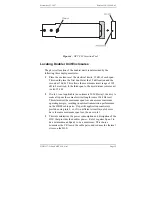
December 22, 1997
Section 150-219-100-02
HDU-217/219 and
HCC-239 List
1
Page 7
You must observe these constraints for reliable service under worst-
case conditions. Consult PairGain when using the enclosures in
environments that are more hostile than those allowed by the
constraints or when using unlisted enclosures. Deployment rules for
determining the the best location for the enclosures are provided in
"Locating Doubler Unit Enclosures" in this practice.
The number of doubler units used in any of the enclosures depends on
the maximum outside ambient temperature. The capacities listed in
Table 2, Table 3, and Table 4 (for both indoor and outdoor
enclosures) are based on a maximum outside temperature of +115
°
F
(+46.1
°
C). These requirements comply with Section 10.2.1.3 of
TA-NWT-001210. The Section requires HDSL equipment placed in
outdoor cabinets to operate in a temperature, outside the housing, of
-40
°
F (-40
°
C) with no solar load and +115
°
F (+46.1
°
C) with
maximum solar load and maximum power dissipation. Full solar load
is equal to the maximum sunlight exposure as defined in
TR-TSY-000057.
The capacities listed for the indoor enclosures in Table 1 assume no
solar load. The capacities listed for the outdoor enclosures in Table 2
and Table 3 assume a full solar load as described above. In order to
reduce thermal stress, the "Recommended Slot Assignment for
Maximum Capacity" column assigns slots according to the following
two rules:
1
Always leave at least one empty slot between adjacent doublers.
2
Allow as much room as possible between doublers.
Slot assignments that differ from those recommended in the tables are
allowed, so long as the above two rules are applied.
The doubler capacity numbers listed for each outdoor enclosure must
be reduced by one for each addi10
°
F (+5.5
°
C) rise (or any
fraction thereof) in outside ambient temperature above +115
°
F
(+46.1
°
C). The doubler capacity number for any application can be
increased by one for those applications having no solar load to bear
(not exposed to direct sunlight, as in manholes). However, any
increase in capacity is still subject to the above rule (1
)
that requires
at least one empty slot between adjacent doubler units in all
applications.












































